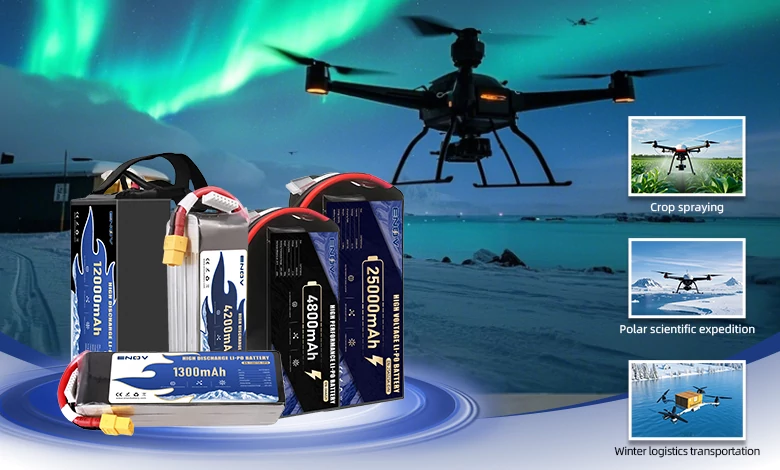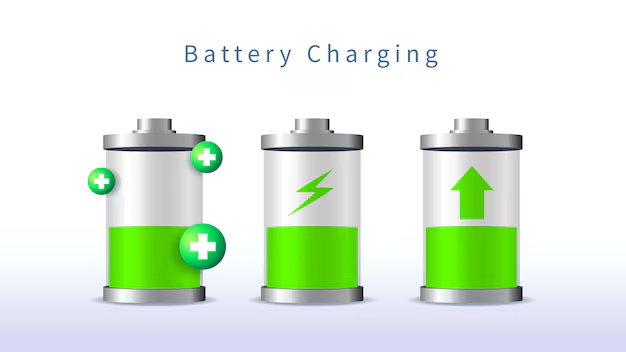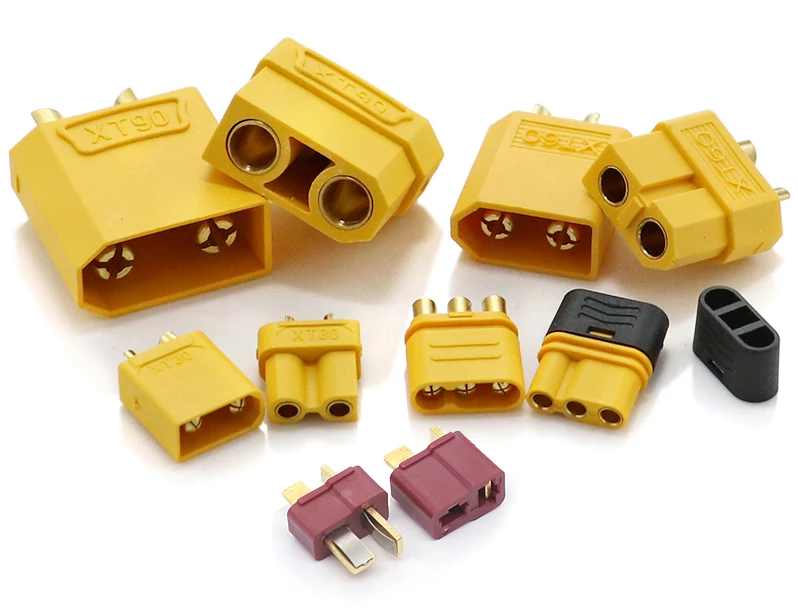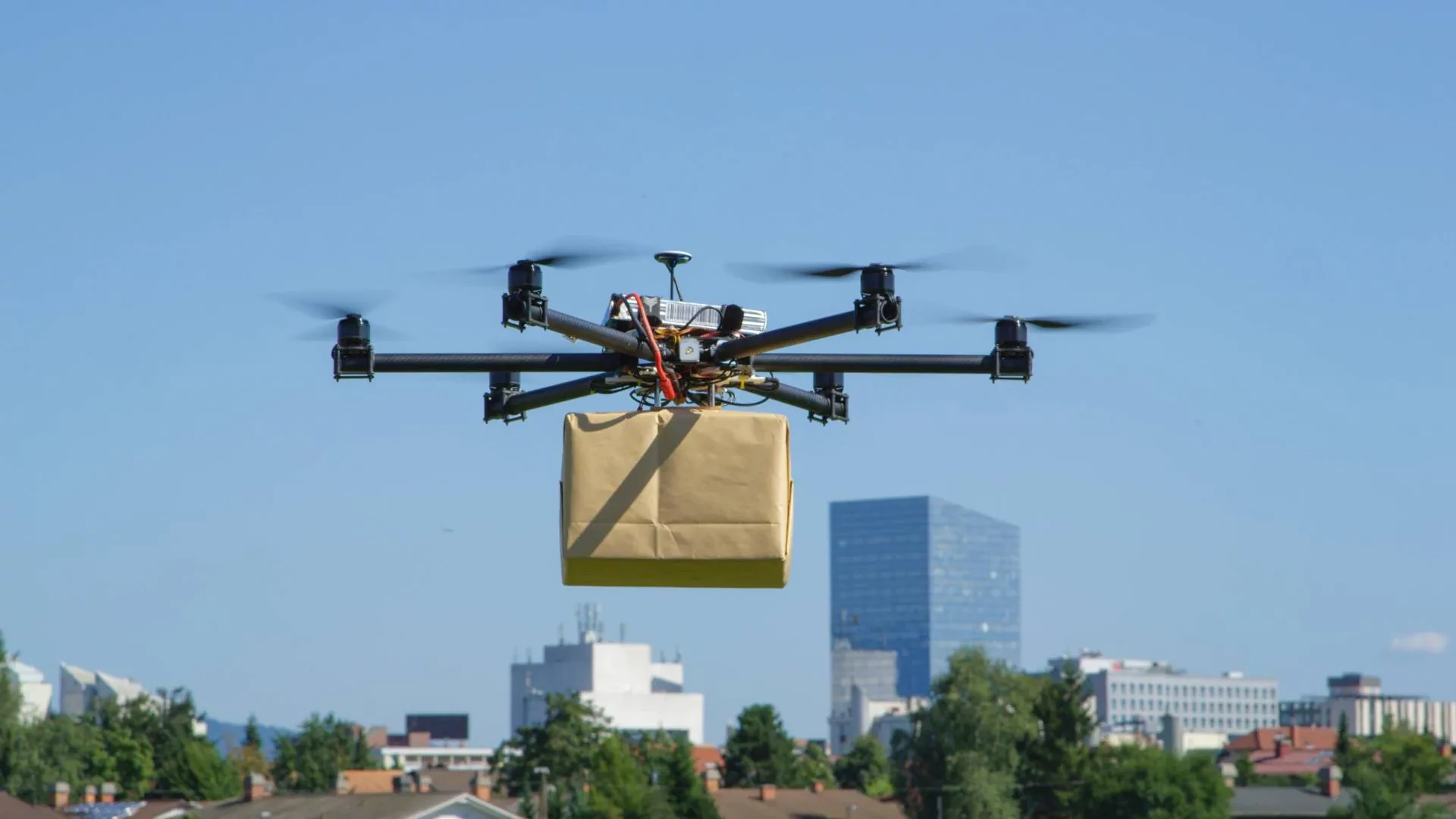Drone Battery Cycle Life: Definition, Influencing Factors, and Optimization Strategies

ENOV High-Energy drone batteries power industrial and commercial drones. Delivering 220–320 Wh/kg energy density, they enable long flight times (30+ mins) and support fast charging (2C). Perfect for aerial photography, surveillance, and delivery drones.
1. Core Definition of Drone Battery Cycle Life
The cycle life of a drone battery refers to the number of complete charge-discharge cycles a battery can undergo before its capacity degrades to a specific threshold of the initial capacity. The industry-standard threshold is 80%, while some manufacturers set it at 60% or 70%, and specific standards should be referred to in the product specifications. Here, “one cycle” does not simply mean a single charge or a single flight, but a process where the cumulative discharge capacity reaches 100%. For example, charging from 50% to 100% and then discharging to 50% constitutes 0.5 cycles; two such operations form one complete cycle.
It should be noted that the end of the cycle life does not mean the battery can no longer be used at all. It just indicates a significant reduction in the battery’s endurance. Taking the capacity degradation to 80% as an example, the battery can still be used continuously. It is only recommended to scrap the battery when its capacity drops below 50% or safety issues arise.
2. Mainstream Drone Battery Types and Their Cycle Life Ranges
Drone batteries made of different chemical materials have significant differences in cycle life due to variations in energy density, safety, weight, and other characteristics. The specific classifications and application scenarios are as follows:
(1) Lithium-Polymer Battery (LiPo)
Cycle Life: 200-500 cycles, and high-quality products can reach up to 800 cycles.
Core Characteristics: Lightweight, high energy density, and high discharge C-rating (some can reach more than 50C), which can meet the demand for short -term high – rate discharge.
Typical Applications: Consumer drones (such as DJI and Autel series) and racing drones, suitable for scenarios that require rapid explosive power.
Precautions: Sensitive to overcharging, over-discharging, and high temperatures, prone to bulging, and requires more meticulous maintenance.
(2) Lithium-Ion Battery (Li-ion)
Cycle Life: 300-1000 cycles, and advanced ternary lithium batteries can reach 500-800 cycles.
Core Characteristics: High stability, better cycle life than lithium-polymer batteries, and energy density between lithium-polymer batteries and lithium iron phosphate batteries.
Typical Applications: High-end consumer drones (such as DJI M350 RTK) and entry-level small drones, suitable for long-endurance inspection and mapping scenarios.
Precautions: Low discharge rate, prone to sudden voltage drop under heavy load, and needs to match the current demand of the drone.
(3) Lithium Iron Phosphate Battery (LiFePO₄)
Cycle Life: 800-2000 cycles, and some industrial-grade products can exceed 2000 cycles.
Core Characteristics: Extremely high safety, good thermal stability, excellent low-temperature performance, and stable voltage output.
Typical Applications: Industrial drones (such as XAG agricultural plant protection drones) and large-scale energy storage supporting drones, suitable for high-frequency operation scenarios with high safety requirements.
Precautions: Low energy density, heavy weight, and larger volume under the same capacity, which may affect the flight efficiency of small drones.
(4) Semi-Solid / Solid-State Batteries
Cycle Life: 1000-10000 cycles.
Core Characteristics: High energy density, strong safety (reducing the risk of electrolyte leakage and thermal runaway), and much longer cycle life than traditional lithium batteries.
Typical Applications: Gradually applied in small batches to high-end industrial drones from 2025, and is expected to become the mainstream choice for long-endurance and high-reliability scenarios in the future.
Precautions: Currently, the cost is relatively high, the large-scale mass production technology is still being improved, and the actual application data is limited.
3. Key Factors Affecting the Cycle Life of Drone Batteries
The actual cycle life of a battery is not a fixed value and is affected by usage habits, environmental conditions, maintenance methods, and other factors. The following factors are the most critical:
(1) Charging and Discharging Habits (The Most Core Factor)
• Depth of Discharge (DOD): Frequent full discharge (discharging to 0%-20%) will accelerate battery aging. The loss rate of full charge and full discharge (0-100%) is more than twice that of shallow charge and shallow discharge (20%-80%). Lithium batteries have a strict voltage range (for example, a single LiPo battery has a nominal voltage of 3.7V, a lower discharge limit of 3.0V, and an upper charging limit of 4.2V). Discharging below the lower limit (over-discharge) will cause irreversible damage to the battery cells, and charging beyond the upper limit (overcharging) may cause bulging and fire.
• Discharge Rate: The discharge rate is measured in “C”. 1C means the current that can fully discharge the battery within 1 hour. Plant protection and racing flights often use 10C-15C high-rate discharge, and their cycle life is 30%-50% lower than that of 1C discharge. High-current discharge will intensify the heating of the battery cells and accelerate the aging of the electrode materials.
• Charging Rate: The cycle life of 2C fast charging is about 30% shorter than that of 0.5C slow charging. Although fast charging is convenient, it will cause the internal temperature to rise, damage the chemical structure of the battery, and significantly reduce the capacity retention rate in long-term use.
(2) Ambient Temperature
Temperature is an “invisible killer” affecting battery life:
• High Temperature (> 40℃): It will accelerate the decomposition of the electrolyte, leading to permanent capacity attenuation. If combined with high-rate discharge, the battery damage will be further aggravated, and the number of cycles can be reduced by more than 50%. Storing the battery in a car or in direct sunlight in summer will greatly accelerate the aging speed.
• Low Temperature (< 0℃): It will increase the internal resistance of the battery cells, leading to increased stress during discharge and a sharp drop in capacity. Long-term low-temperature storage may also cause lithium dendrite precipitation, resulting in permanent damage. Charging in a low-temperature environment will lead to the formation of an anode coating and damage the chemical properties of the battery.
(3) Storage Conditions
• State of Charge: Long-term storage with a full charge (such as being fully charged and left idle for several months) will make the battery cells under high pressure and accelerate the capacity attenuation rate. Long-term storage with an empty charge (discharging to 0% and then leaving it idle) may cause the battery cells to “deeply hibernate” and cannot be activated again. The optimal charge range for long-term storage (more than 1 month) is 40%-60%, and for short-term storage (1-2 weeks), it can be maintained at 20%-80%.
• Storage Environment: A high-humidity and dusty environment will cause corrosion of the connectors. Severe temperature fluctuations will accelerate aging. The ideal storage environment is 15-25℃, dry and well-ventilated, and should be far away from heat sources, humid places, and direct sunlight.
(4) Battery Management and Physical State
• Battery Management System (BMS): A BMS with balanced charging, voltage/temperature protection functions can extend the battery’s cycle life by 20%-40%. If the BMS function is missing or faulty, it will lead to unbalanced cell voltages, overcharging and over-discharging of some cells, and accelerate the overall aging.
• Physical Damage and Natural Aging: Collisions, squeezes, and punctures (such as flight crashes and handling drops) will cause deformation and leakage of the battery cells, directly ending the battery’s life. Even if not used, the battery will naturally age due to electrolyte volatilization and electrode material oxidation, and its capacity will decrease significantly after 1-2 years.
4. Practical Tips for Extending the Cycle Life of Drone Batteries
Through scientific use and maintenance, the original cycle life of 200 times can be extended to more than 300 times, which greatly reduces the long-term use cost. The specific measures are as follows:
(1) Optimize Charging and Discharging Operations
• Adhere to “Shallow Charge and Shallow Discharge”: Avoid discharging below 20% during daily flights, and it is not necessary to charge to 100% every time (charging to 90% is sufficient for daily use) to reduce the number of deep cycles. A complete charge-discharge cycle (fully discharging to 20% and then fully charging) can be carried out every 50 cycles to calibrate the battery capacity detection.
• Control the Charging and Discharging Rate: Prioritize the 0.5C-1C standard charging mode, and do not use fast charging above 2C unless in an emergency. Select a battery whose discharge rating is much higher than the normal current consumption of the drone. For example, if the conventional current consumption of the drone is 30A, a battery with a rated current of more than 45A can be selected to avoid long-term full-load discharge.
• Cool the Battery Before Charging After Flight: The battery will heat up after flight. Charging immediately will intensify the temperature rise. The battery needs to be cooled to room temperature (15-25℃) before charging to prevent overheating damage to the battery cells.
(2) Standardize Storage Management
• Set the “Storage Mode”: Most smart batteries support the “Storage Mode”, which can automatically adjust the charge to 40%-60%. For batteries that are not used for a long time (more than 1 month), the charge needs to be manually adjusted to this range and stored in a dry environment at 15-25℃. Do not put them in the refrigerator or a high-temperature car.
• Regularly Activate Hibernating Batteries: For batteries that are idle for a long time, charge and discharge them once every 1-3 months (charge to 60% and then discharge to 30%) to prevent the battery cells from hibernating. Avoid leaving the battery unused for more than 6 months without activation, otherwise, the capacity may not be restored.
(3) Daily Maintenance and Inspection
• Balanced Charging: For multi-cell battery packs, a charger with a balancing function should be used to ensure that the voltage of each cell is consistent and prevent overcharging and over-discharging of some cells. The balancing stage should be completed every time charging is performed. Even if it takes longer, it can maximize the battery life.
• Regular Physical Inspection: Check the appearance of the battery before and after flight. If there is bulging, leakage, or shell cracking, stop using it immediately and scrap it. Check whether the connector is dirty, corroded, or loose. A soft brush can be used to remove debris, and contact cleaner can be applied if necessary to avoid a voltage drop or electric arc caused by poor contact.
• Record Battery Health Data: Record the cycle count, flight time, landing voltage, and temperature of each battery through the drone’s supporting APP or third-party tools. If a sudden reduction in endurance is found (for example, it could originally fly for 20 minutes, but now only 10 minutes), or charging jumps (suddenly showing full charge when charged to 50%), timely investigation or battery replacement is required.
(4) Avoid Extreme Usage Scenarios
• Control Flight Load and Style: Avoid frequent “violent flying” such as sudden acceleration, sudden descent, and high-speed maneuvering to reduce the high-current discharge pressure on the battery. For scenarios such as mapping and cruising, try to maintain medium-speed flight to reduce the discharge rate.
• Adapt to Ambient Temperature: Before taking off in a high-temperature environment, the battery can be pre-cooled by shading and ventilation. Before flying in a low-temperature environment (< 10℃), the battery needs to be preheated to above 15℃ (a dedicated heating bag can be used) to avoid low-temperature discharge damage.
5. Clarification of Common Misunderstandings
• Misunderstanding 1: “Number of Cycles = Number of Charges”
This is incorrect. One cycle is a process where the “cumulative discharge capacity reaches 100%”, not one charge counting as one cycle. For example, charging from 80% to 100% and then discharging to 80% only completes 0.2 cycles.
• Misunderstanding 2: “The Battery Can No Longer Be Used When Its Capacity Drops to 80%”
This is wrong. 80% is the “end of cycle life” defined by manufacturers. At this time, the battery can still be used, but its endurance will decrease. It is only recommended to scrap the battery when its capacity is below 50% or safety issues such as bulging and abnormal voltage occur.
• Misunderstanding 3: “Third-party Batteries Are Cheaper and Have Similar Cycle Life”
This is incorrect. To reduce costs, most third-party batteries use low-quality cells or simplified BMS protection circuits. Their cycle life may only be half of that of original batteries, and they have higher safety risks during overcharging and over-discharging. It is recommended to give priority to original or brand-certified batteries.
• Misunderstanding 4: “Lithium Iron Phosphate Batteries Are Heavy and Not Necessary to Choose”
This is wrong. Although lithium iron phosphate batteries are relatively heavy, in industrial drones (such as agricultural plant protection and long-term inspection), their long cycle life of 800-2000 times can greatly reduce the replacement frequency, resulting in lower long-term use costs, and their safety is far better than that of lithium-polymer batteries.
6. Criteria for Judging Battery Aging and Scrap
When a battery has the following conditions, it must be stopped using and replaced immediately, regardless of the number of cycles, to avoid safety risks:
• Abnormal Appearance: The battery is bulging, the shell is cracked, leaking, or there are obvious signs of extrusion and puncture on the surface.
• Abnormal Performance: The endurance time is reduced by more than 30% compared with a new battery, the charging time is significantly shortened (actual capacity decreases), and the “battery voltage abnormality” alarm is frequently triggered during flight.
• Abnormal Temperature: The battery heats up abnormally (exceeding 45℃) during charging or flight, or the temperature of one cell is significantly higher than that of the other cells.
• Abnormal Voltage: In a multi-cell battery pack, the voltage difference between one cell and another cell exceeds 0.1V, and it cannot be restored after balanced charging.
Scrapped batteries must be disposed of in accordance with local hazardous waste disposal regulations and must not be discarded at will. Some hobby stores and battery manufacturers in some cities provide recycling services, and professional institutions can be contacted for disposal to avoid environmental pollution or safety accidents.
Quick inquiry
Drop us a line, and we’ll get back to you within 24 hours.

Ariana Yuan
Digital Operations Manager
Website Planning|Marketing Project Management for Drone Batteries|Scheduled Content Refresh|SEO Optimization

Ariana Yuan
Digital Operations Manager
Website Planning|Marketing Project Management for Drone Batteries|Scheduled Content Refresh|SEO Optimization




